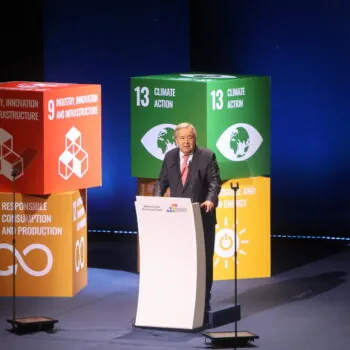In a move that shocked the world, President Xi Jinping of China, in close collaboration with President Obama, announced China’s intention to peak its carbon emissions around 2030 at the APEC summit in Beijing last week.[1] This marks a turning point for China’s insatiable growth and sets out a path for a more sustainable and low carbon economic transformation. It also sends out a clear signal to investors as China seeks to mainstream green and low carbon investment across its economy.
There has been a growing focus on the green/low carbon investment agenda even before Xi’s announcement. Since 2011, spending on environmental protection has increased by roughly $30 billion each year. During the 12th Five-Year Plan (2011-2015), the overall financing on environmental projects would reach $816 billion.[2] Similarly, investment in climate change related projects exploded over the last few years, with an annual average climate finance of $87.6 billion (546 billion RMB) from 2008-2012.[3] However, these are far from adequate given the huge demand for green investment in China – according to Energy Research Institute (ERI), China’s total financing need for decarbonising its energy industry and for energy efficiency under a 2-degree scenario reaches $453 billion (2.8251 trillion RMB) per annum in 2030.[4] A recent report by E3G highlighted challenges that might derail China’s decarbonisation pathway, including the fragmented approach to financial reform and green investment, and the artificial division between green and climate financing.[5]
As part of our Sino-Europe sustainable urban development project, E3G organised a “Workshop on Low Carbon Finance: Supporting Hubei’s Urbanisation and Industrialisation” in Wuhan on 5 November 2014. The objective of the workshop was to share information and lessons about the latest developments in low carbon finance in China, Europe and worldwide to support the decarbonisation effort in Hubei, in particular the role of finance in integrating cleaner and low carbon investment choices across its economy. Hubei Province is located in the eastern most part of Central China and has a population of over 57 million. Hubei is one of the seven emission trading scheme (ETS) pilots in China as well as a low carbon pilot province. Being a ‘middle-income’ province (its GDP ranks 11th in the country)[6] and an important industry base, Hubei province is representative of the “developing” China, distinct from the richer coastal regions such as Beijing, Shanghai and Guangdong. The provincial government faces huge challenges in financing the low carbon transformation needed: Wuhan (the capital of Hubei) currently has one of the highest local government debts in China and needs to spend $329 billion in urban construction over the next five years.
Although the Workshop was well received by local stakeholders such as Hubei Development and Reform Commission (DRC), emission trading bodies and municipal governments, it also highlighted the challenges faced by China in attracting green/low carbon investment especially at the provincial level. This is a critical concern as although policy and regulations are set by the central government, the task to implement them mostly falls on provincial governments. At a time when the central government is tightening up local governments’ debt levels, and the on-going financial reform has yet to produce clear mandates for new ways of raising funds, local governments are struggling to attract innovative and green investment for low carbon urbanisation and industrialisation. Unlike their eastern counterparts, provinces in central and western China such as Hubei have less access and exposure to public finance vehicles and mechanisms set up by the central government, such as China CDM Fund. This is particularly important as public finance plays an essential role in unlocking investments in new ‘green/low carbon’ areas and leveraging private investments. In addition, it also has less room to experiment with new instruments due to the immaturity of the financial market.
To ensure that China delivers on its promise, it needs to help provinces build up capacity and ability to raise funds and attract investment for green/low carbon projects. It should create a policy and regulatory framework that promotes effective sharing of information and encourages local innovation of financial mechanisms and instruments. It also needs to establish efficient networks of and access to financing sources, both national and international, for local actors. In particular, the promotion of mechanisms such as public-private partnerships (PPPs) and ‘green investment bank’ type institutions needs to be realised on the ground, with central government providing clear and transparent guidelines as well as seed funding for local experimentation. In addition, there should be incentives for regional banks and local branches of national banks to work closely with local governments in exploring new financing instruments targeting green and low carbon development, such as guarantees and bonds.
Ultimately, China needs a more joined-up approach – both vertically (between the different levels of governance) and horizontally (between the different government departments) – to finance a greener and lower carbon development pathway from now until 2030. In January 2015, E3G and the Central University of Finance and Economics (CUFE) of China will launch a multi-stakeholder China Platform for Dialogue on Financing a Cleaner Development Pathway to build collective understanding of the investment challenges associated with making the transition to a low carbon economy in 2030. This Platform will bring together Chinese decision-makers from government, finance, industry and thinktanks to consider issues at the interface of green/low carbon finance and financial reform, in order to create integrated thinking and problem-solving across the different agendas. This could be the first step towards enhancing Chinese government’s capacity to leverage scaled up green/low carbon investment from the private sector.
[1] US-China Joint Announcement on Climate Change https://www.whitehouse.gov/the-press-office/2014/11/11/us-china-joint-announcement-climate-change
[2] China Spends Big on Environmenthttps://www.chinadaily.com.cn/bizchina/greenchina/2014-03/08/content_17334364.htm, China Daily (8 March 2014)
[3] Chen Bo and Wang Yao, China’s Climate Finance and Investment Gap, Central University of Finance and Economy (CUFE), July 2014
[4] Jiang Kejun, China’s Investment Pathway to 2030, Energy Research Institute (ERI), July 2014
[5] Amal-Lee Amin et al., China’s Low Carbon Finance and Investment Pathway, E3G Policy Paper, July 2014


